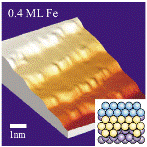Department of Physics and Astronomy: Publications and Other Research

Axel Enders Publications
Document Type
Article
Date of this Version
2002
Abstract
Adsorbate and thermally induced changes of the spin reorientation transition in Fe wedges grown at 140 K on Cu(001) substrates are investigated by the magneto-optical Kerr effect and Kerr microscopy. The adsorption of oxygen causes a complete reorientation of the easy axis of magnetization into the film plane. In contrast to that carbon monoxide decreases the critical thickness for the reorientation transition of the film by 0.7 monolayer down to 3.6 monolayers, while films thinner than 3.6 monolayers remain magnetized perpendicularly. These adsorbate-induced changes can be ascribed to a change in the surface magnetic anisotropy. Also annealing of the films up to 300 K causes a temperature-dependent nonlinear shift of the critical thickness. This shift can be separated in reversible and irreversible contributions which arise from temperature-dependent anisotropy constants and thermally induced structural changes of the film, respectively.


Comments
Published in PHYSICAL REVIEW B 66, 104411 (2002). ©2002 The American Physical Society. Used by permission.